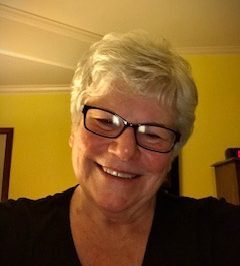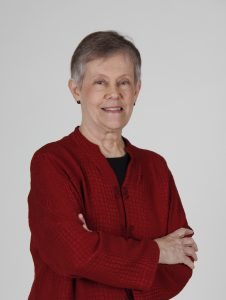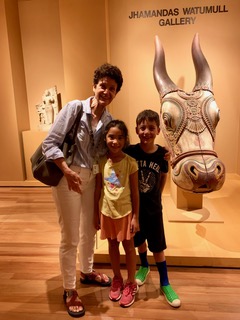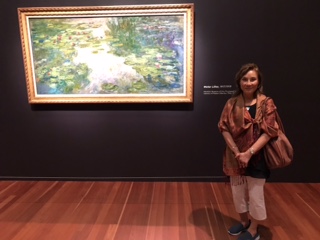Despite challenges, HoMA docents continue to bring the museum experience to life
HoMA’s docents play an integral role in welcoming visitors to the museum and bringing the museum’s collection and exhibitions to life, even in a year like this one. 2020 presented challenge after challenge, forcing the docent role at the museum to pivot and change—and our docent team barely skipped a beat.
Director of Learning and Engagement Aaron Padilla elaborated, “It’s been nothing short of amazing how our docent team embraced the opportunity to evolve in many ways we never considered. They continue to be keepers of HoMA’s stories and history, now through new and different modes of engagement. Their work on digital peer learning groups, the HoMA Book Club, and the Gallery Activation Project has helped move HoMA forward in these difficult times. The docents’ unconditional efforts often go unnoticed, and it’s so important that they receive the recognition they so rightly deserve.”
We asked a group of HoMA docents a few questions about their experiences this year, how their roles at the museum have changed, and what they’re most looking forward to in future months.
How have the HoMA docents adapted to the current realities and challenges of the pandemic?
Docent Kathy Krammer explained “Docents treasure being able to share their passion for art and all the stories and ways of appreciating it with our visitors. Having it suddenly stripped away last March was initially shocking to HoMA docents, as it has been for docents throughout the world. For purposes of personal and safety of others it became a difficult transition to determine how we all maintain our value to the museum, a place we vest so much of our lives and passions. This led to looking inward and answering the a question, ‘What is a docent?’?
I asked this question in the weekly newsletter and gleaned responses that identified the role as a passionate teacher about art, artists, the times in which they lived and the art was produced. There were specifics about slow looking at art and all the variables that go into each piece. Being a docent is about creativity, and includes children and adults and weaves in literature, film, and the art of storytelling.”

Kathy Krammer
Kathy Krammer
Kathy continued, “HoMA Docents have participated in docent-led virtual tours and discussions with the Walter’s Museum in Baltimore and the Crystal Bridges Museum in Arkansas. These were very successful, and those docents have asked for reciprocity with our museum when we are ready to go virtual. The Getty Museum will be presenting to us in February or March and wants to participate in our ‘From Docents, For Docents’ (FDFD) program. They have initiated a Curator’s Club (a FDFD-like program) with nationwide docent participation. We will present later in 2021. In addition, we participated in the ‘Slow Art’ short course in November.
Docents were requested and actively participated in the Gallery Activation Project’s Art in Context and Art in Conversation. Their written presentations are already on exhibit and the project has widened to include more. At present audio recordings are being made for the next phase. There is also future planning for guided virtual tours for the public and other museum docents.”
Docent Nancy Miwa said “I believe docents have been remarkably resilient throughout this last year. Aaron, Kathy, and I have tried to maintain an open channel of communication to keep docents current on museum business and engaged in continuing their learning through several museum sponsored programs. Janna Plant and Mindi Gandara have reached out with opportunities for docents to write and record text for the Gallery Activation Project. The museum Book Club is lead by docents and attended by many. Our unique docent-led FDFD presentations give a docents the chance to research and then present a topic of their choice. And Zoom cocktails have helped keep us connected socially.”

Nancy Miwa
Nancy Miwa
“We all want to get back to face to face touring,” Nancy said. “That is why many of us become docents. But let’s face it, most of us are in a high risk category. So we recognize the seriousness of seeing this pandemic through patiently until we can all get back to being together in person again.”
How has the pandemic has changed the way in which docents have stayed engaged with the museum, as well as with others across the country?
Docent Bob Oaks explains, “What I have been doing for the past nearly ten months was totally unexpected, totally interesting, and totally fun! It all started in late April when a friend in the Bay Area sent me an email suggesting that I do a Zoom virtual docent tour of some aspect of the San Francisco Asian Art Museum (where I am also a docent). I readily agreed, thinking I would do ‘a’ (i.e., one) session on jade. There were 5 or 6 people who watched that first ‘show.’ And darn if they didn’t want more! So each week for many months I did a weekly hour long chat on Monday mornings (with a little help from others, more on that below). It seems that each week more people heard about it and they in turn told others. At first, they were just friends and a couple of relatives, no docents. Friends in Honolulu also began tuning in, including a couple of HoMA docents and soon it was listed each week in the docent newsletter.”

Bob oaks
Bob Oaks
“My list of ‘friends’ grew very quickly, and before long I was drawing 20 to 30 people in ultimately 10 states and five time zone! I had a few helpers on subjects I didn’t know a lot about: Carol Root did a session on the HoMA Indonesian gallery, Mary Rhyne, now in San Diego, did one on Indonesian textiles, and two Shangri La docents (Mae Mendelson and Dietra Cordia) each did one on Islamic art. Despite their help, I was beginning to run out of material. At that point wonderful Cathy Levinson approached Tom Kolbe, Emeritus Professor of Art History at UH and a specialist on Islamic Art, to see if he would give us more on that topic. And did that ever make the group of attendees grow! Now there are around 50 who show up on Monday mornings.
I think this effort is about to end, but it has been a great run (and fun) for me. It also has been a way for docents in Honolulu to keep in touch with their comrades, even those who have moved to places in California, Colorado, Florida, and elsewhere. The lesson I learned is that there is interest out there for this kind of docenting. Probably only about half of my attendees are docents; the rest just general public looking for something interesting to watch. And it can all be done in shorts and t-shirt!”

Marcia Morse
Marcia Morse
Said docent Marcia Morse, “Nothing can take the place of having a good face-to-face conversation with a museum visitor, or helping a student figure out how linear perspective works, but HoMA’s docents are a very resourceful and creative group! For the moment, we are not on the front lines of the museum experience, but we have found other ways to stay connected to the museum we love and the art that inspires us.”
“Looking outward, we have found ways to reach out to, and share resources with, other docent communities across the country. Looking inward, we have focused on our own continuing education and maintaining continuity in some programs that could be adapted to online experience. One example is the Docent Book Club, which I co-chair with docent Pam Redding. We meet regularly to discuss selected books that have some link to artwork on view—selections from our permanent collection, or a special temporary exhibition. At the moment, instead of touring in the galleries as part of our discussion, the lead docent prepares a slide show (e.g., PowerPoint), providing a virtual tour. While docents regularly participate in the Book Club, it is also open to the whole museum community. Please join us in January 2021!”
What’s the one thing you look forward to the most when programming and tours return to HoMA?
Docent Hannah Slovin told us “I look forward to school children visiting HoMA again. HoMA’s children’s programs have always meant a lot to me. My first experience was a parent-and-child art class I attended with my then three-year-old son. Many years later, I had the opportunity to train as a docent and lead school tours.”

Hannah Slovin
Hannah Slovin enjoying the museum with two of her grandchildren, Molly and Tyler
“For many of the children on school trips to the museum, it is their first visit. Kids are wonderful observers. They are open and ask sincere questions. On one tour, a group of fifth-graders were looking at the Early American art in gallery 13. One child, focusing on the Rothko at the opposite end of the gallery, blurted out, ‘Why would that be in a museum?’ We finished our discussion and walked over to the Rothko. I asked, ‘Why do you think you noticed this painting?’ What followed was a lively group discussion about color, shape and composition—all ideas that came from the children.”
Docent Greg Spencer said, “The thing I really miss is ARTafterDARK where I could be a docent in specific galleries and be able to greet and discuss art with so many folks that did not initially come for the art nor were ‘into art’ (vs. a social event). When it was only specific galleries I needed to concentrate on, I could become an ‘art expert’ very easily and be able to answer all questions and provide much excitement and incentive to our guests to ‘get into art’. Many of the folks I initially met while doing ARTafterDARK came back looking for me on later ARTafterDARK events which really made me feel good about the outreach ability of this program and how it makes art fun vs. a boring thing, and hopefully drives them to ‘get into the arts’ in the future.”

Greg and Mary
Greg and Mary Spencer at last year’s Kamaʻāina Christmas event
Another activity I most look forward to is benefit events such as Kamaʻāina Christmas where Mary [Spencer] and I both volunteered last year. Looking forward so much to it happening again.”
Docent Mary Spencer said “There are so many things I miss about HoMA: the staff, the visitors, the events…but what I’m looking forward to most is curator talks. I’m fascinated with the knowledge and insights of how exhibitions are planned, executed, and displayed. Artists often participate in curator talks about contemporary arts; what an honor it is to be inspired by these talks and then share the stories with our visitors. I have learned so much from our visitors as well.”

Water Lilies
Mary Spencer with Monet’s “Water Lilies,” on loan to the de Young Museum in 2019.
Mahalo to the entire HoMA docent team for their incredible dedication to bringing the artwork to life, and continuing to enrich the museum experience for the rest of us.